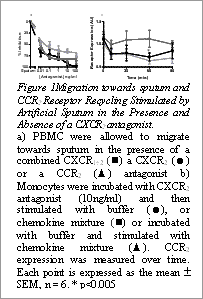The chemotactic properties of sputum in chronic obstructive pulmonary disease: a role for specific chemokine receptor antagonists Elevated inflammatory cell migration to sites of airway damage is a key feature of many lung diseases, including chronic obstructive pulmonary disease (COPD). The increased macrophages in the lungs of COPD patients have the capacity to cause all the pathological features of this disease. Understanding the mechanisms behind leukocyte migratory responses might offer novel therapeutic targets for treatment. Previously, we demonstrated that growth related oncogene (GRO)α (CXCL1), interleukin (IL)-8 (CXCL8), and monocyte chemoattractant protein (MCP)-1 (CCL2) are chemotactic for monocytes, with elevated migration for COPD patient cells in response to GROα . The reasons for this are unclear but an increase in receptor number is not responsible.
However, CXCR2 is recycled back to the cell surface more rapidly in cells from COPD patients when exposed to GROα , but not IL-8 (Traves et al., 2004). Since these chemokines are elevated in COPD sputum, the aims of this study were to determine (i) the chemotactic capacity of induced sputum (IS), (ii) the nature of the IS chemotactic response using specific chemokine receptor antagonists and (iii) whether this response was specific for sputum using a chemokine mixture. IS was obtained from COPD patients and controls (n=6) via the inhalation of hypertonic saline and used as a chemoattractant for peripheral blood mononuclear cells (PBMC) from non-smokers using a Boyden Chamber. PBMC demonstrated enhanced migration towards IS from COPD patients when compared with migration towards IS from normal smokers and non-smokers (73±3 vs. 39±3 vs. 42±3 cells/field, n=6, p<0.05). Migration towards IS was almost completely inhibited by the presence of specific receptor antagonists (EC50 CXCR2 (SB332235 N-(2-hydroxy-3-sulfamyl-4-chlorophenyl)-N’-2,3-dichlorophenyl)urea):0.01±0.002, CXCR1+2 (SB468477 N-(2-Hydroxy-3-dimethylsulfonylamido-4-chhlorophenyl)-N’-(2-bromophenyl)-N”-cyanoguanidine):0.2±0.2, CCR2 (SB 399721): 0.03±0.03 ng/ml, n=6) (Figure 1a). Similar results were obtained when a chemokine mixture was substituted for COPD sputum. One reason for this could be direct interactions between chemokine receptors. This chemokine mixture of IL-8, GROα and MCP-1 stimulated recycling of the CCR2 receptor in both the presence and absence of the CXCR2 antagonist denoted by a significant decrease in receptor expression at 60 min (Figure 1b). This indicates that CCR2 is still recycling normally in the presence of the CXCR2 antagonist yet migration does not occur. In summary these data suggest that the antagonists inhibit migration by altering receptor-receptor interactions such as the downstream signalling mechanisms which regulate migration. These results highlight a role for specific receptor antagonists in reducing the inflammatory cell infiltrate into the airways.
Traves, S. L., Smith, S. J., Barnes, P. J., and Donnelly, L. E. (2004) J Leukoc. Biol. 76, 441-450. |


